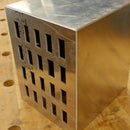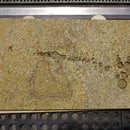Introduction: Pier 9 Guide: T-962A Reflow Oven
This Instructable is for Workshop Users at Pier 9.
Requirements for using the T-962A and Electronics Lab
- Take General Workshop Safety Class.
- Take Electronics Lab Orientation Class.
- Read through this Instructable.
If you are working with electronics and soldering you might have already had contact with surface-mounted devices (a.k.a. SMDs). Soldering these tiny parts by hand is near impossible. This is where a reflow oven for soldering SMDs is essential.
Commercial reflow ovens usually cost in the range of thousands dollars. Many people build their own reflow-soldering oven out of a toaster, but this particular brand, the T-962A is a low-cost solution.
First off, when you get your T-962A, I would recommend this Instructable, which details how to modify the oven so that it doesn't emit a nasty smell from the masking tape burning (use Kapton tape instead).
A note on the heat distribution
The temperature distribution is not particularly even — there is no circulating fan — and the same Instructable as above details a fix for this.
This is due to the nature of infrared heat, which is absorbed at different rates depending on the surface color. For example, black ICs get heated up quickly, but metal parts will heat up at a slower rate.
Modern reflow ovens mostly use convection technology, but are more expensive. These ovens use moving air to deliver the heat, which will distribute heat much more evenly than this oven.
Step 1: Acceptable Materials for the Oven
The oven should be used only for circuit boards with SMD components and solder paste.
Through-hole components should be manually soldered and should be done after the SMD soldering
What cannot go in the oven:
* anything flammable
* 3D prints
* batteries
* screens (LCD, OLED, etc)
* any sort of paper
* any kind of tape (except Kapton is okay)
* anything that contains epoxy
Step 2: Power Up the Oven
The power switch is on the back of the oven, on the left side.
When you turn it on, the device will make a whirring noise and show you a startup screen.
Press the [S] button to get you to the main menu.
Press [F4] to change languages, if needed. Your choices are either English or Mandarin.
Step 3: Load Your Piece Into the Tray
Open up the tray door, put your prepared surface mount piece in the tray (how to lay out SMD boards is not covered in this Instructable). Then, close the tray.
Step 4: Selecting a Profile
The T-962A has eight different temperature profiles. These profiles are used to let the temperature even out between different parts of the PCB. Different profiles are useful for different types of components
Press [F3] to select a temperature profile.
Use [F1] (forward) or [F2] (back) to scroll between the profiles.
The recommended one that we use is: Wave #8 (W8)
Here are the notes on some of the profiles.
W3 = reliable
W5 = low temp
W6 = boards with big chunky components and no sensitive components
W7 = when board is all tiny SMD components
W8 = works for most everything including BGAs (ball grid arrays)
Press [F4] to choose the temperature profile
This will take you back to the main page. The F4 button can be a little finicky, due to buggy embedded software so sometimes you have to press extra hard on the button.
Also note that sometime the language will get changed in the process of going back to the main menu. If this happens, just hit F4 again.
Note: There is no feedback at this point on which temperature profile you've selected.
Step 5: Turn on the Venting System
This only applies to Pier 9 users at the Autodesk facilities, though it’s good practice to use these ovens in a ventilated room.
When using the oven, you must turn on the venting system and position it over the vent for the oven.
1. Turn on the venting system. The switch is underneath the seating area on the right side of the soldering table.
2. Switch the vent tube to the on position by pulling the U-shaped lever up to match the direction of the airflow.
3. Position the vent tube over the right side of the T-962A oven, which is where the outtake fan is located.
Step 6: Activate the Oven
Press F1 to begin the automatic temperature activation.
This will take you to a screen which will show a timed baking process.
Your selected temperature profile should be visible at this point.
The oven automatically begins its baking cycle at this point
The cycle takes about 7-12 minutes. Note that the time shown on the oven is not correct at all — while the reflow profile may say it takes only 7 minutes, it can take up to 12 minutes, depending on the profile. The W8 profile takes 10 minutes.
For Pier 9 users, you must stay in the Electronics Lab during the entire duration of the baking process.
Step 7: Done!
When the oven is finished, it will just emit a steady and very annoying beep.
Press [S] to turn the oven off.
Pull out the tray. Remove your newly-soldered component. You may want to use a hot mitt since it will be slightly hot.
Turn off the power to the oven.








![Tim's Mechanical Spider Leg [LU9685-20CU]](https://content.instructables.com/FFB/5R4I/LVKZ6G6R/FFB5R4ILVKZ6G6R.png?auto=webp&crop=1.2%3A1&frame=1&width=306)




